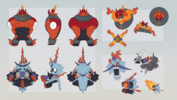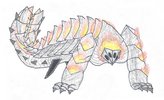These designs are overall inspired by several extinct taxa within the clade,
Sphenacodontia, a stem-based clade of derived synapsids that includes both modern mammals and the somewhat less derived offshoots of their distant ancestors from the Permian era. The most famous of these by far is the sailbacked
Dimetrodon (which is not actually a dinosaur, despite what certain layperson claims would have you believe!), which I used as the main animal basis for the "Aria Form" or, as I like to call it, the "Heating Mode". The precise function of this genus' iconic sail has been a subject of debate since 1940, when it was first proposed as a thermoregulatory device for absorbing or dissipating heat. Studies on this idea have presented differing conclusions either in support of or against it, but it's now thought that the sail instead evolved as a visual display structure, as most of its smaller relatives like
Sphenacodon itself had either much shorter crests or ridges down their backs or no sails at all - if the sail really was meant for body temperature control, then you'd think it'd have been more common among sphenacodonts as a whole, especially in smaller taxa with less body mass for retaining heat. Still, the idea of
Dimetrodon using its sail as a heat sink or solar panel was irresistible for a Fire-type, though integrating the other two types was anything but easy! My first idea for the base form was to have the sail actually
be a solar panel, but the sheer amount of fakemon I've seen based on that concept says more than enough about its popularity that I had to get a little more creative. Luckily, after remembering that the sweeper form was an Ice-type, I ultimately hit upon a better idea that in turn informed pretty much the entirety of the second form...
Building off the way
Dimetrodon's sail has been compared in older palaeo-media to a radiator, I took that comparison a step further for this design and turned it into a built-in
heating, ventilation, and air conditioning (HVAC) system. The pipes on the edge and middle of the sail, passing through the three struts holding it up, are an extension of this CAP sub's respiratory system, cycling any air it's inhaled through special thermoregulatory elements of its internal anatomy, cooling or warming the air as required for it to live in any and all conditions and habitats regardless of how hot or cold they are. In its "Heating Mode", the sail also acts as a heat sink and disperser, its membrane glowing red-hot as it sheds excess thermal energy as if the creature's back is literally on fire. Air traveling through the pipes crossing the heat sink is then altered through convection with the rest of its body, cooling its blood on the way in and then taking unwanted heat along with it as it's expelled through the vents on its shoulders, hips, and the end of its tail. Thus, this creature's main form of attack is to spew either blasts of fiery hot vapor in the defensive form or jets of freezing cold air in the offensive one. And speaking of the latter...
After I suspected, correctly, that the second form for this CAP was more than likely going to be insanely fast, I decided to use that high speed stat to inform the look of my own sub's second form - the "Cooling Mode", if you will. To this end, its legs are longer and more upright, and the shoulder and hip vents are now turned backwards to shoot their icy exhaust with tremendous force, effectively serving as a built-in jet propulsion system. This is in turn a visual pun on
cold gas thrusters, which don't need ignition of the gaseous fuel they store to propel any aircraft or rocket that includes them in its assembly. The body proportions also now harken more to
Inostrancevia, arguably the best-known member of the extinct clade of saber-toothed therapsids from the Middle to the Upper Permian called the
gorgonopsids, than the lizard-like "pelycosaur" look of the base form, and the legs and feet are explicitly longer and held below the body like on a true dinosaur or a mammal, therefore looking better adapted for fast running. This visual change also reflects the old idea of
Dimetrodon and other ancient sail-backed creatures being thought to have had a precursor to the ability seen in most animals today to maintain a steady body temperature with an active metabolism - in other words, it's turning from an
ectotherm (whose body temperature is dependent on its environment) into an
endotherm (whose body temperature is independent of that of its surroundings), allowing it to actively maintain its usual energy levels even in borderline polar conditions. In this case, its body heat is now being directed towards its vital organs to keep them active, causing most of its skin to freeze over, forming icy armor on its legs where their armor plating used to be. Furthermore, not only does the sail on its back become so freezing cold that a thin mist of condensation surrounds its snowstorm-patterned membrane, but a coat of solid ice now covers the struts of said sail in the form of huge, sharp spikes, which also handily references research conclusions indicating that the spines supporting the sail membrane had exposed tips (as opposed to the full-sail look of its portrayal in vintage films, though not to the extent of a few more recent depictions greatly reducing the sail membrane itself with some particularly egregious cases having only the struts
themselves growing from the spine). The rest of the back has a coating of
hoar frost, so named for its resemblance to hair; I'm not sure how prominent a palaeomeme it was to depict Dimetrodon as having either a naked leathery hide or straight-up covered in fur, but certain details gleaned from the fossil material of some later therapsid taxa do hint at the presence of at least a little bit of the stuff (
like whiskers, for instance). The shift between the two forms of this design therefore represents the change in how
Dimetrodon and other stem-mammals have been depicted over the ages, with its appearance transitioning from entirely (if somewhat erroneously) reptilian to more visibly mammalian.











































